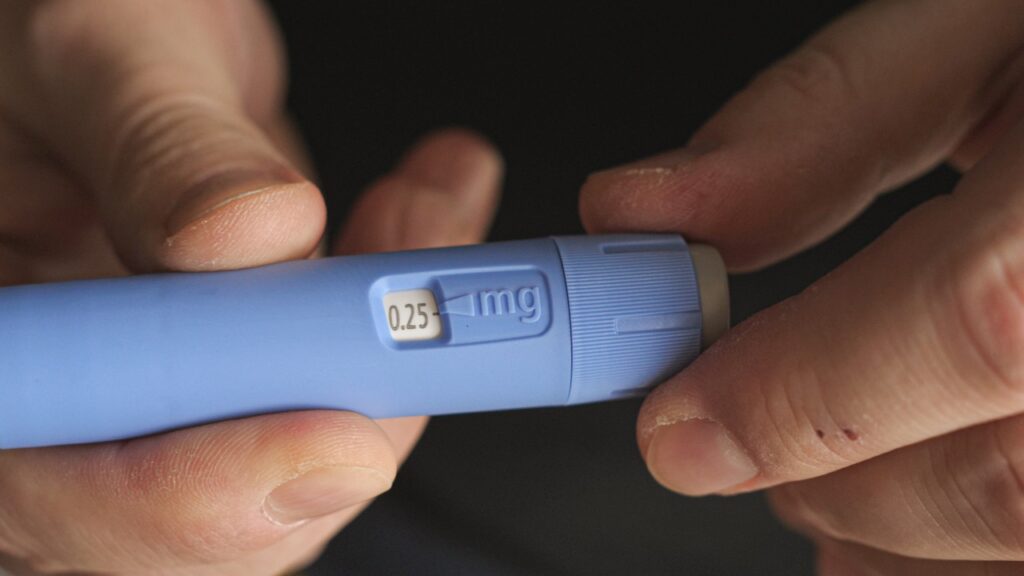Can i get Ozempic in Canada?
If you’re wondering whether or not Ozempic is available in Canada, the short answer is: yes, it is! But getting your hands on the drug won’t be as easy as walking into your local pharmacy.
So how exactly do you get hold of Ozempic if you’re in Canada?
In this article we’ll cover:
- What Ozempic is
- Whether or not you need a prescription for its use
- Where you can get an Ozempic prescription in Canada
- Any restrictions on who can access Ozempic in Canada
- How to qualify for an Ozempic prescription
- Who could benefit from it
- How Ozempic is used for weight loss
- Instructions for how to administer your Ozempic injection
- Frequently asked questions.
Let’s get started!
What is Ozempic?
Ozempic is part of a class of drugs known as glucagon-like peptide-1 (GLP-1) receptor agonists. These medications work by mimicking natural hormones in your body
How does Ozempic work?
It is primarily used to manage type-2 diabetes, helping patients control their blood sugar levels when combined with a healthy diet and exercise. It works by slowing down digestion, which reduces appetite, and also promotes insulin secretion when blood sugar levels get too high.
Apart from its function in diabetes care, Ozempic has garnered a lot of attention from the media for its other benefit — weight loss.
Many users report significant weight loss while on this medication, leading to its popularity not only among those with diabetes but also those looking to lose substantial amounts of weight. You can read more about Ozempic Weight Loss here.
Do You Need a Prescription for Ozempic?
Yes, in Canada, Ozempic is a prescription only medication.
Given its foremost purpose is for managing type-2 diabetes, it is essential that its use is overseen by a medical team. This helps to ensure that it is used safely, taking into account the patient’s health history, current condition, and other medications they are using.
Where Can You Get a Prescription for Ozempic in Canada?
In Canada, prescriptions for medications such as Ozempic can only be given out by a licensed healthcare professional, like a family physician or Nurse Practitioner. This means you’ll need to visit a medical professional.
You can get a prescription in various healthcare settings across Canada, from walk-in clinics, to family medicine practices, to telemedicine providers..
Telemedicine has also grown in popularity, especially since the pandemic, and some medical teams may offer virtual consultations. This means you may not have to physically visit a clinic. However, this only applies to Canadian residents and citizens — those visiting from out of the country will have to see a doctor in person.
Once you have your prescription, it can be filled at any licensed pharmacy. Pharmacists in both major chains, mail order, and local independent pharmacies can provide the prescribed dose for you, and offer additional information about the medication.
Are There Restrictions on Who Can Get an Ozempic Prescription in Canada?
Yes, there are certain restrictions on who can receive a prescription for Ozempic in Canada.
It’s important to remember that Ozempic and semaglutide are prescription drugs intended for the treatment of type-2 diabetes. It is not suitable for everyone and can only be prescribed by a qualified healthcare provider, such as a doctor, Nurse Practitioner, or endocrinologist, who will assess a patient’s eligibility based on their medical history and current health condition.
Some key restrictions include:
- Type of Diabetes Ozempic is indicated for the treatment of type-2 diabetes. It is not used for treating type-1 diabetes or diabetic ketoacidosis.
- Other Health Conditions Patients with certain health conditions may not be suitable for Ozempic treatment.
For example, it is not recommended for those with a personal or family history of medullary thyroid carcinoma, or multiple endocrine neoplasia syndrome type 2.
People with a history of pancreatitis may also need to avoid this medication, as it has been known to cause pancreatitis.
- Age Ozempic is typically not prescribed to children or adolescents under 18, as it has not been adequately studied in this age group.
- Pregnancy and Breastfeeding The safety of Ozempic for use during pregnancy or breastfeeding is not established, and thus is usually not recommended for these individuals.
- Allergies People who have had allergic reactions to semaglutide or any other ingredient in Ozempic should not use the medication.
Remember, a doctor or healthcare provider is the best person to discuss these and any other potential restrictions or risks. They will evaluate your specific situation, consider the potential benefits and risks of the medication, and decide whether Ozempic is the right option for you.
In terms of access, Health Canada, government bodies, and various provinces and territories might have additional regulations or guidelines that could influence who can receive a prescription for Ozempic. This underscores the importance of a comprehensive and open conversation with your healthcare provider. For an idea of the cost, you can refer to the Ozempic Cost Canada page.
The cost can also be a limiting factor for some people. Although some Canadian provinces may cover part of the cost of Ozempic under public drug benefit plans, coverage varies across provinces. Some private insurance plans may cover the medication, but generally use of Ozempic may not be covered by your insurance. You can check the Ozempic Costco Canada Cost for a reference. Patients should verify their insurance coverage and the potential out-of-pocket cost of this medication.
It’s also important to note that a recent crackdown on non-Canadians attempting to purchase Ozempic has resulted in Adrian Dix’s bill limiting the sale of Ozempic in British Columbia to those resident in countries outside of Canada. The move comes in response to a surge in demand from the United States, fuelled by celebrities and online influencers touting the drug’s weight loss benefits.
A provincial analysis revealed that during the first two months of the year, 15% of Ozempic sales went to U.S. residents, a figure Dix called “worryingly high”, especially when compared to the less-than-half-a-percent average for other prescription products.
Amid concerns over potential shortages and the ability to meet the needs of Canadian consumers, the varying Canadian healthcare regulatory bodies aim to ensure reliable access to this crucial medication for its residents.
How Do You Qualify for an Ozempic Prescription?
In Canada, the process of qualifying for an Ozempic prescription involves an evaluation by a health professional. It is largely prescribed for those with unmanaged type-2 diabetes, but recently the scope has broadened to include weight loss patients in some instances.
Individuals with a body mass index (BMI) of 27 or higher, who also have at least one weight-related comorbidity such as type-2 diabetes, high blood pressure, or high cholesterol, may be considered candidates for Ozempic.
However, despite this approval, not everyone within this criteria will automatically qualify. Some factors that will affect a doctor’s decision on the matter include your overall health, other medications you may be on, and family history of certain conditions.
Additionally, the doctor will also consider whether the patient is capable and willing to follow the prescribed treatment plan, as Ozempic requires a commitment to a regular injection schedule.
Have You Been Prescribed Ozempic?
Ozempic is the brand name for the generic drug semaglutide. Your doctor may refer to it as semaglutide instead of Ozempic. It may also be referred to by its class of drugs, glucagon-like peptide-1 (GLP-1) receptor agonists.
If your doctor talks to you about prescribing something to help you manage type-2 diabetes or to help with weight loss, clarify with them whether or not they are talking about Ozempic.
Who Can Benefit from Ozempic?
Anyone who has type-2 diabetes or ongoing weight management issues could potentially benefit from the use of Ozempic.
As stated previously, Ozempic works by mimicking hormones in the body which help to regulate blood sugar levels, slow digestion and reduce appetite. This makes it useful as part of a treatment plan for type 2 diabetes.
It can also benefit those who are overweight or obese, particularly when they have conditions like high blood pressure or high cholesterol.
Although use of Ozempic for weight loss is technically off label, Health Canada has approved semaglutide for weight management in those with a BMI higher than 27 that also have one of these weight-related comorbidities.
Ozempic for Weight Loss
Semaglutide, the active ingredient in Ozempic, can be helpful in promoting weight loss by slowing down digestion, which reduces appetite.
This can lead to a decrease in the amount of food consumed, leading to a calorie deficit and weight loss.
However, you should be aware that — when used for weight loss — Ozempic is most effective along with lifestyle changes and a slow and steady regime.
Can This Diabetes Medication Help Me Shed Pounds?
The short answer is yes! Clinical trials and real-world reports have confirmed that many people experience significant weight loss while on Ozempic, particularly those with a higher BMI and weight-related comorbidities.
This has led to Health Canada, among other health organizations worldwide, approving Ozempic for weight management in specific situations.
Remember, though, that while Ozempic can be a useful tool for weight loss, it should be used as part of a comprehensive weight management plan that includes dietary changes and physical activity.
How Can I Use Ozempic for the Best Results?
To get the best weight loss results from using Ozempic, you need to make sure you stick to following everything to the letter. Your doctor will advise you regarding doses, frequency and injection technique, and it’s important to follow these instructions carefully.
You also will need to combine using Ozempic with making lifestyle changes like improving your diet and getting regular exercise in order to get the full benefits of the medication.
What Is the Right Ozempic Dosage?
The right dose of Ozempic depends on the individual, but usually starts out at a lower dose and is gradually increased. This helps prevent side effects.
Type-2 diabetics typically start with 0.25 mg weekly for four weeks, then increasing their dose to 0.5 mg.
For weight loss, the dosage will differ based on a variety of factors, including your weight, your comorbidities and your family history. Therefore, you’ll need to discuss the subject thoroughly with your healthcare provider.
What are Ozempic Side Effects?
Ozempic does not come without potential side effects. Here are some possible complications: • GI issues, including nausea, diarrhea and stomach pain
- Low blood sugar, particularly if combined with other diabetes medications
- Fatigue
- Dizziness, especially at the beginning of when the dose is increased
- Pancreatitis
- Ozemped is linked to an increased risk of thyroid cell tumors when tested in animals, but it is not yet known if this effect is seen in humans
- Allergic reactions.
There are also some contraindications for Ozempic, so if you have previous or current health issues, or are on other medications, you should disclose this to your health provider.
Your healthcare provider will be able to talk you through the full list of side effects and the likelihood of them occurring.
Further Instructions on the Administration of Ozempic Injection
Follow the Instructions of the Manufacturer Novo Nordisk, the manufacturer of Ozempic, provides detailed instructions with each package of the medication. It is crucial to read and follow these instructions carefully.
Instructions cover important topics, such as:
- Dosage
- Preparation of the injection
- Administration techniques
- Storage
- What to do in case of a missed dose.
If you have any questions or need clarification, don’t hesitate to reach out to your pharmacist or healthcare provider.
Choose the Right Injection Site
Ozemptic is injected subcutaneously, into the fatty layer of tissue under the skin. Good injection sites include the front of the thighs, the abdomen, or the upper arm.
Varying the injection site weekly is important to avoid developing lipodystrophy and ensure the medication is absorbed properly.
Be sure to avoid injecting into moles, scars, or areas where there is damage to the skin.
Prepare the Injection
Ozemptic comes in a pen that is pre-filled and ready for you to use.
Before administering your dose, ensure your hands are clean and make sure you have everything on hand: the Ozempic pen, a new needle, and a needle disposal container.
Set the correct dose and attach the new needle to the pen, as per the manufacturer’s instructions.
Administer the Injection
After choosing your injection site, swab the area with an alcohol wipe and allow it to dry. Then remove the outer needle cap and hold the pen at a 90º angle to the skin.
Press the button all the way in to inject the dose. Hold the button and slowly count to six before removing the needle from the skin, to make sure the full dose is delivered.
After injecting, dispose of the needle safely in your sharps container.
Store the Medication Properly
Ozempic is not effective if you don’t store it properly.
Unused pens should be stored in the refrigerator, away from the freezer compartment. Once in use, pens can be kept at room temperature for up to 56 days.
Always keep the pen cap on when not in use.
Follow a Healthy Diet and Exercise Program
While Ozempic can be valuable for managing type-2 diabetes and potentially helping with weight loss, it needs to be used in conjunction with a balanced diet and exercise for best results.
Ensure you are in a calorie deficit, and consider working with a Registered Dietitian or personal trainer to develop a meal and exercise plan.
Key Takeaways
Ozempic is widely available across Canada, and a physician must provide the prescription after considering the patient’s health condition and needs.
This medication, a GLP-1 agonist, offers dual benefits in managing blood sugar levels and aiding in weight loss, especially when incorporated into a comprehensive care plan that includes diet and exercise.
Dosage typically starts at a lower level and is gradually increased to minimize side effects.
It’s important to remember that while Ozempic can be a useful tool for weight loss, it should be used as part of a comprehensive weight management plan that includes dietary changes and physical activity.
The cost of Ozempic can vary, and it’s important to check with your insurance provider to understand the coverage and out-of-pocket expenses.
Always consult with your healthcare provider for personalized advice and guidance.
Remember, your health is your wealth!
Ozempic Canada FAQs
Is Ozempic available in Canada for weight loss?
Yes, Ozempic is available in Canada, not only for the treatment of type-2 diabetes but also in the management of weight. The latter use has been approved for individuals with a body mass index (BMI) of 27 kg/m^2 or higher, who also have at least one weight-related comorbidity, such as high blood pressure or high cholesterol.
Is Ozempic covered in Canada?
Coverage for Ozempic in Canada varies depending on the specific provincial healthcare plan and individual’s private health insurance.
Some provinces and territories may cover the cost under their public health plans. It is more likely to be covered by private insurance for diabetes patients, than for weight loss patients.
Patients should consult their health insurance provider for precise info on coverage.
Do I need a prescription for Ozempic in Canada?
Yes, a prescription is required for Ozempic in Canada.
The prescription process is part of a careful assessment to ensure that the patient’s health condition warrants the use of Ozempic, and that the potential benefits outweigh the risks. This consideration is especially important given Ozempic’s potential side effects, such as the risk of pancreatitis.






